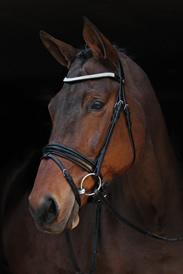Part III of series on Bridles
By Jochen Schleese, CMS, CSFT, CSE
©2018 Saddlefit 4 Life® All Rights Reserved
In this instalment in my series on bridles, I want to list a number of the most popular bridles available with some of their features and benefits. For all of the different designs, remember that nosebands which are too restrictive can cause the horse to focus on the tension and pressure in and on his head, limiting the ability to focus and respond with proper muscle movement in the rest of his body. The horse’s biology does not change from discipline to discipline in riding, even though the ‘head-restraining devices’ do – all of which are designed to control and communicate to the horse what the rider wants. The horse will learn what to do to relieve pressure and discomfort, which can have further ramifications at the distal end of the body as he attempts to avoid pain. Give the horse the freedom to communicate using its mouth – comfort will result in a quiet, relaxed jaw and mouth.
Snaffle with a Flash Noseband (rolled reins, throatlatch, cheekpieces, and noseband)
This commonly used type has an additional flash to assist in keeping the horse’s mouth shut (and the tongue in). The noseband should be buckled high enough to avoid interfering with the (generally) snaffle bit.
Swedish Bridle or Snaffle With a Flash Noseband
Extra padding under the noseband buckle makes this more comfortable than the English style bridle. Other than that, it is very similar to the combination bridle, with the extra flash. Care must be taken that the anatomy of the head allows enough room to buckle both the noseband and the flash properly. Horses with relatively smaller heads do well with this type. This bridle is often buckled too tightly, given the false sense of ‘comfort’ the extra padding at the noseband provides.
English or Snaffle Bridle
The noseband on this bridle should lie 1-2 fingers below the zygomatic arch. It is popular for thoroughbreds, who prefer more freedom in their mouths. If your horse likes to put his tongue over the bit, this is not a style for you. Using a rolled noseband puts more pressure on the nose as well.
HANOVERIAN or Drop-Noseband Bridle
The noseband lies about 4 fingers above the nostrils past the bit. This style used to be much more popular, but it is not a pretty looking bridle. It relays the pressure from the reins directly from the lower jaw onto the nose. It does prevent horses from putting their tongues over the bit. Some riders still prefer to use this as it has less leather and buckles, which lowers the risk of impacting sensitive nerves and acupuncture points.
MEXICAN, GRACKLE or Figure 8 Bridle
Loose snaffle rings and the ability to breathe without hindrance are two of the main attractions of this bridle. It is easily recognizable, having crossing leather straps over the nose with a leather rosette in the centre. The upper piece crosses the zygomatic arch. The only pressure point is in the centre from the rosette piece. It has only recently been allowed for use in dressage rings. The only danger is if it is buckled too tightly and thus pushes the bit up into the corners of the lips.
Hackamore
This bitless option puts pressure on the nose through a lever action at the sides of the noseband. Although probably effective for a while, the horse soon gets accustomed to the pressure on the nose and becomes less responsive over time. It’s a good alternative for interim use if a horse has an injury in the mouth, but there is almost no substitute for the necessary additional aid of an outside rein in the higher classes.
Micklem Bridle
This option has an extra strap attaching the bit to the bridle. It is extremely comfortable for the horse, and supports the ‘chewing’ motion.
Here is an excellent checklist regarding the use of nosebands:
a) Educate yourself on the nerves, functions, and anatomy of the horse’s head.
b) How sensitive is your horse? Highly sensitive horses do best with no nosebands or loose ones.
c) Determine the best type to fit your horse’s nose shape and head conformation.
d) Your horse still needs to have full physiological movement: yawn, swallow and lick its lips.
e) Use padding judiciously – most bridles are already made to provide full comfort and extra padding can increase the pressure.
f) Listen to your horse. Tension creates tension; restriction creates restriction.
The new, totally custom, anatomically correct bridles which are now available purport to help your horse perform better by relieving pressure on the sensitive areas of the head and head. To sort out all the options that are available, riders should educate themselves to understand the conformation of the horse’s head to make the right decision for their horse(s). One size, one type, one make, does definitely not fit all! A well-fitted, appropriately padded ergonomically designed bridle will help to distribute pressure more evenly – good for the horse, but also good for riders who may have less-educated hands.













